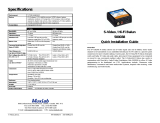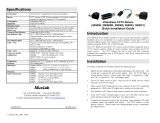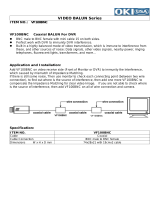Page is loading ...

VideoEase
™
Passive CCTV Hub (500130,500131)
Installation Guide
P/N: 94-000604-A, SE-000413-A

© MuxLab Inc. Passive CCTV Hub Installation Guide
P
a
g
e 2
Copyright Notice :
Copyright © 2005 MuxLab Inc. All rights reserved.
Printed in Canada. No part of this publication may be reproduced, stored in a retrieval
system, or transmitted in any form or by any means, electronic, mechanical,
photocopying, recording, or otherwise without prior written permission of the author.
Trademarks :
MuxLab and VideoEase are registered trademarks of MuxLab Inc.

© MuxLab Inc. Passive CCTV Hub Installation Guide
P
a
g
e 3
Table of Contents
1. Overview ...................................................................................................................4
1.1. Description........................................................................................................4
1.2. Features.............................................................................................................4
2. Technical Specifications...........................................................................................5
3. Installation Procedure..............................................................................................6
3.1. Parts List ...........................................................................................................6
3.2. Product Overview .............................................................................................6
3.3. Pre-Installation Checklist .................................................................................7
3.4. Physical Installation..........................................................................................8
3.5. Installation Procedure - Model 500130 ............................................................9
3.6. Installation Procedure - Model 500131 ..........................................................13
4. Troubleshooting......................................................................................................18
5. Distance Tables.......................................................................................................19
6. Product Warranty Policy.......................................................................................21

© MuxLab Inc. Passive CCTV Hub Installation Guide
P
a
g
e 4
1.
Overview
1.1. Description
The Passive CCTV Hub allows video, remote power and PTZ control to be
transmitted via one 4-pair Cat 5 cable, thus eliminating the need to install
multiple cables for more efficient cabling in the security video environment.
There are two 16-port models: 500130; for coax video output and the 500131;
for twisted pair video output.
The Passive CCTV Hub works in conjunction with MuxLab’s 500000,
500009, 500015, 500022, 500023, 500024, 500029, 500120 and 500122. The
product features a port switch to set the unit to Power-Thru or Pass-Thru
mode.
1.2. Features
• Port switch to set unit to Pass-Thru Mode (500022) or Power-Thru Mode
(500024/500029)
• Pin configuration chart on unit
• Space efficient, rack-mountable

© MuxLab Inc. Passive CCTV Hub Installation Guide
P
a
g
e 5
2.
Technical Specifications
Specifications
Environment
Composite video; NTSC, PAL, SECAM
Devices
CCTV cameras, DVRs, monitors, switchers, multiplexers and other CCTV equip.
Transmission
Transparent to the user.
Video
Bandwidth
DC to 8 MHz.
Maximum Input
1.1Vp-p
Insertion Loss
Less than 2 dB per pair over the frequency range from DC to 8 MHz
Return Loss
Greater than 15 dB over the frequency range from DC to 8 MHz
Common Mode Rejection
Greater than 40 dB @ 8 MHz
Max. Distance - Color
Cat 3 –1,200 ft (365m); Cat 5 – 2,200 ft. (670m)*
*Shorter distances will result with DVR equipment. Typically 1,000 to 1,500 ft
Max. Distance - B&W
Cat 3 –1,500 ft (457m); Cat 5 – 2,500 ft (762m)
Remote Power
Switch Mode Pass-Thru Mode (500022) Power-Thru Mode (500024/500029)
Number of twisted pairs
Two (2) Three (3)
Max. Distance @ 24VAC*
*Based on 10% voltage drop at
camera. Longer distances may
be achieved @ 28 VAC.
5 VA: 350 ft (107m) 10 VA: 175 ft
(53m)
20 VA: 90 ft (30m) 30 VA: 60 ft (20m)
5 VA: 518 ft (170m) 10 VA: 259 ft (85
m)
20 VA: 130 ft (43 m) 30 VA: 86 ft (28 m)
Maximum Input Voltage
50 Volts (AC RMS/DC). Recommended Class II PSU with fuse protection per port
Maximum Current Rating
4.5A (AC RMS/DC)
2-Wire PTZ Control (i.e. RS-422, Manchester/Bi-Phase, half duplex RS485) – Pass-Thru Mode (500022)
Wiring
Remote 2-wire PTZ control supported via one (1) twisted pair.
Maximum Distance
Up to 4,000 ft (1.2 km) depending on the PTZ camera vendor**
**Please consult your CCTV equipment vendor for more detailed performance
specifications.
Maximum Power Rating
50 Volts (AC RMS/DC); 3A (AC RMS/DC)
Mechanical & Environmental
Cable – UTP
24 AWG or lower solid copper twisted pair wire impedance: 100 ohms at 1 MHz
Maximum capacitance: 20 pf/foot. Attenuation: 6.6 dB/1000 ft at 1 MHz
Cable – Coax
Impedance: 75 Ω at 1 MHz. (RG59/U). Max. 25 ft. of coax allowed end to end.
Connectors
Video (Model 500130): Sixteen (16) BNC-F
Video (Model 500131): Sixteen (16) 2-pole screw terminals
Power: Sixteen (16) 2-pole screw terminals
Control: Sixteen (16) 2-pole screw terminals.
Combined signals: Sixteen (16) RJ45 jacks
Port Configuration Switch
Sets each port to Pass-Thru Mode (500022) or Power-Thru Mode (500024/500029)
RJ45 Pin Configuration* Signal 500022 Mode 500024/500029 Mode
*Reverse polarity sensitive
Power A (+) 1, 3 1, 3, 5
Power B (-) 2, 6 2, 4, 6
Control (+) 4 Not used
Control (-) 5 Not used
Video BNC Center (Tip) 7 [T] opposite to 500000 7 [T] opposite to 500000
Video BNC Ground (Ring) 8 [R] opposite to 500000 8 [R] opposite to 500000
Temperature
Operating: 0° to 55°C. Storage:-20° to 85°C. Humidity: up to 95%
Enclosure
Black, anodized aluminum
Dimensions
19” (48.26 cm) W x 1.75” (4.4 cm) H x 2.0” ( 5.1 cm) D
Weight
2.3 lbs. (1.1kgs)
Warranty
Lifetime
Order Information
500130 Passive CCTV Hub, UTP/Coax
500131 Passive CCTV Hub, UTP/UTP

© MuxLab Inc. Passive CCTV Hub Installation Guide
P
a
g
e 6
3.
Installation Procedure
3.1. Parts List
The Passive CCTV Hub comes with the following parts. Please verify that all
pieces are present before proceeding.
• Base Unit (Factory configuration: Power-Thru Mode (500022)
• Installation Guide
3.2. Product Overview
The external connections of the Passive CCTV Hub are detailed in the
following diagrams. Please familiarize yourself with them before installing the
unit.
Figure 1: Front panel, all models
Figure 2: Rear panel, Model 500130 (UTP/Coax)
Figure 3: Rear panel: Model 500131 (UTP/UTP)

© MuxLab Inc. Passive CCTV Hub Installation Guide
P
a
g
e 7
3.3. Pre-Installation Checklist
The Passive CCTV Hub provides a centralized sixteen (16) port CCTV copper
twisted pair cabling solution.
1. The Passive CCTV Hub is used in a CCTV installation to manage the
video, power and control connections between the CCTV cameras and the
head-end.
2. There are two (2) models of the Passive CCTV Hub; 500130 and 500131.
The difference between the 500130 and 500131 is that the video portion of
the 500130 incorporates a video balun at each port and is connected to the
DVR via coaxial cable. The video portion of the 500131 is fully twisted
pair on the input and output and connected to the DVR via twisted pair
cable. In order to convert from twisted pair back to coax, a CCTV video
balun is connected at each DVR port.
3. The products feature a switch at each port to select between Pass-Thru
Mode (500022 compatible) or Power-Thru Mode (500024/500029
compatible) depending on the cabling configuration.
4. The Passive CCTV Hub works in conjunction with MuxLab’s other CCTV
products including the 500000, 500009, 500015, 500022, 500023, 500024,
500029, 500120 and 500122). The passive CCTV Baluns are connected at
the CCTV camera.
5. The Passive CCTV Hub works with CCTV cameras that have built-in
twisted pair baluns. It may be necessary to reverse the polarity of the wires
first. Distance performance may vary.

© MuxLab Inc. Passive CCTV Hub Installation Guide
P
a
g
e 8
3.4. Physical Installation
The Passive CCTV Hub is a 1U, 19” rackmount unit. The factory default
switch settings of each port is Pass-Thru Mode (500022).
1. Select the final destination for the product in the relay rack and install the
unit using standard rackmount screws.
Figure 4: Rack-mount installation

© MuxLab Inc. Passive CCTV Hub Installation Guide
P
a
g
e 9
3.5. Installation Procedure – Model 500130
The Passive CCTV Hub, Model 500130 features BNC connectors on the video
portion of the device, thereby allowing it to be connected directly to the DVR
via coaxial cable. In order to install the product in this configuration, please
follow the steps below:
1. Install the Passive CCTV Hub in its final location. Please verify that the
distance between the rack and cameras are within MuxLab specifications.
2. Connect a MuxLab passive CCTV Balun (MuxLab p/n 500000, 500009,
500022, 500023, 500024 or 500029) to each CCTV camera video output.
Please refer to the appropriate CCTV balun installation guide for details.
3. Connect one Cat5 cable from each camera to one of the modular RJ45
ports on the front of the Passive CCTV Hub (fig 5). Please ensure that EIA
568 wiring and straight-through polarity is respected between the CCTV
balun and the rack. The use of other Cat5 connection hardware such as
patch panels and 110 blocks may be used.
Figure 5: Camera connection

© MuxLab Inc. Passive CCTV Hub Installation Guide
P
a
g
e 10
Port Switch Settings:
4. For each camera port, determine whether video, power and/or control is to
be transmitted via the same Cat5 cable. If only video is to be transmitted,
then the Power/Control terminals and port switch may be disregarded.
5. In order to transmit video on one (1) twisted pair, remote power on two (2)
twisted pairs and control on one (1) twisted pair, set the port switch to
Pass-Thru Mode (500022) using a small flathead screwdriver, as shown in
fig 6. Ensure that there is a CCTV Pass-Thru Balun (500022) at the
camera.
Figure 6: Port Setting – Pass-Thru Mode (500022)
6. In order to transmit video on one (1) twisted pair and remote power on
three (3) twisted pairs, set the port switch to Power-Thru Mode
(500024/500029) using a small flathead screwdriver (fig 7). Ensure that
there is a CCTV Power-Thru Balun (500024 or 500029) at the camera.
Figure 7: Port Setting – Power-Thru Mode (500024/500029)

© MuxLab Inc. Passive CCTV Hub Installation Guide
P
a
g
e 11
Output Connections:
Video:
7. Connect one coax cable between each video output port on the rack and the
DVR video input (fig 8).
Figure 8: Video connection, Model 500130
Remote Power:
8. If remote power is being transmitted to the camera, verify that the distance
between the camera and the hub is within MuxLab specifications. Please
consult the distance charts at the back of the installation guide. When the
port switch is set to Pass-Thru Mode (500022), two (2) twisted pairs are
used for remote power. When the port switch is set to Power-Thru Mode
(500024/500029), three (3) twisted pairs are used for remote power thus
supporting greater distance.
9. Connect two (2) wires between the power terminals of the hub to the
remote low voltage power supply (fig 9). It is recommended to use a
Class II power supply with fuse protection on each output port.
Figure 9: Remote power connection, Model 500130

© MuxLab Inc. Passive CCTV Hub Installation Guide
P
a
g
e 12
PTZ Control:
10. If PTZ Control is to be transmitted to the camera, verify that the distance
between the camera and the hub is within the distance specifications for
sending PTZ control over twisted pair. Consult the PTZ equipment vendor
for maximum distances. Please ensure that the port switch is set to Pass-
Thru Mode (500022). When the port switch is set to Pass-Thru Mode
(500022), one (1) twisted pair is used for PTZ control. For optimum
results, it is recommended to use control protocols such as RS-422, RS-485
or Bi-phase. Due to crosstalk issues, RS-232 is not recommended.
11. Connect two (2) wires between the PTZ controller and the “Control”
terminals on the hub (fig 10).
Figure 10: PTZ connection, Model 500130
12. Power on the CCTV equipment; cameras, remote power supply, PTZ
controller.
13. The following diagram shows a typical configuration.
Figure 11: Typical Configuration, Model 500130

© MuxLab Inc. Passive CCTV Hub Installation Guide
P
a
g
e 13
3.6. Installation Procedure – Model 500131
The Passive CCTV Hub, Model 500131 features screw terminal connectors on
the video portion of the device, thereby allowing it to be connected via twisted
pair to the head end equipment (DVR). Video baluns, such as the 500009,
must be used at the DVR to convert back to coaxial cable. In order to install
the product in this configuration, please follow the steps below:
1. Install the Passive CCTV Hub in its final location. Please verify that the
distance between the cameras and the head end are within MuxLab
specifications.
2. Connect a MuxLab passive CCTV Balun (MuxLab p/n 500000, 500009,
500022, 500023, 500024 or 500029) to each CCTV camera video output.
Please refer to the appropriate CCTV balun installation guide for details.
3. Connect one Cat5 cable from each camera to one of the modular RJ45
ports on the front of the Passive CCTV Hub (fig 12). Please ensure that
EIA 568 wiring and straight-through polarity is respected between the
CCTV balun and the rack. The use of other Cat5 connection hardware
such as patch panels and 110 blocks may be used.
Figure 12: Camera connection
Port Switch Settings:
4. For each camera port, determine whether video, power and/or control is to
be transmitted via the same Cat5 cable. If only video is to be transmitted,
then the Power/Control terminals and port switch may be disregarded.

© MuxLab Inc. Passive CCTV Hub Installation Guide
P
a
g
e 14
5. In order to transmit video on one (1) twisted pair, remote power on two (2)
twisted pairs and control on one (1) twisted pair, set the port switch to
Pass-Thru Mode (500022) as shown in figure 13. Ensure that there is a
CCTV Pass-Thru Balun (500022) at the camera.
Figure 13: Port Setting – Pass-Thru Mode (500022)
6. In order to transmit video on one (1) twisted pair and remote power on
three (3) twisted pairs, set the port switch to Power-Thru Mode
(500024/500029) as shown in figure 14. Ensure that there is a CCTV
Power-Thru Balun (500024 or 500029) at the camera.
Figure 14: Port Setting – Power-Thru Mode (500024/500029)
Output Connections:
Video:
7. Install a CCTV balun on each port of the DVR. The products that may be
connected include; 500000, 500009, 500015, 5000023 or 500122.

© MuxLab Inc. Passive CCTV Hub Installation Guide
P
a
g
e 15
8. Connect one (1) twisted pair for video between the hub and the balun on
the DVR (fig 15).
Figure 15: Video connection, Model 500131
Remote Power:
9. If remote power is being transmitted to the camera, verify that the distance
between the camera and the hub is within MuxLab specifications. Please
consult the distance charts at the back of the installation guide. When the
port switch is set to Pass-Thru Mode (500022), two (2) twisted pairs are
used for remote power. When the port switch is set to Power-Thru Mode
(500024/500029), three (3) twisted pairs are used for remote power thus
supporting greater distance.
10. Connect two (2) wires between the power terminals of the hub to the
remote low voltage power supply (fig 16). It is recommended to use a
Class II power supply with fuse protection on each output port.
Figure 16: Remote power connection, Model 500131

© MuxLab Inc. Passive CCTV Hub Installation Guide
P
a
g
e 16
PTZ Control:
11. If PTZ Control is to be transmitted to the camera, verify that the distance
between the camera and the hub is within the distance specifications for
sending PTZ control over twisted pair. Consult the PTZ equipment vendor
for maximum distances. Please ensure that the port switch is set to Pass-
Thru Mode (500022). When the port switch is set to Pass-Thru Mode
(500022), one (1) twisted pair is used for PTZ control. For optimum
results, it is recommended to use control protocols such as RS-422, RS-485
or Bi-phase. Due to crosstalk issues, RS-232 is not recommended.
12. Connect two (2) wires between the PTZ controller and the “Control”
terminals on the hub (fig 17).
Figure 17: PTZ connection, Model 500131

© MuxLab Inc. Passive CCTV Hub Installation Guide
P
a
g
e 17
13. Power on the CCTV equipment; cameras, remote power supply, PTZ
controller. The following diagram shows a typical configuration.
Figure 18: Typical Configuration, Model 500131

© MuxLab Inc. Passive CCTV Hub Installation Guide
P
a
g
e 18
4.
Troubleshooting
The following chart describes some of the problem symptoms, the probable causes and
possible solutions. If the information below does not solve the problem, please contact
MuxLab Technical Support at 877-689-5228 (North America) or at (+1) 514 905-0588
(International) or via e-mail at [email protected].
Picture Probable Causes Possible Solutions
No video image
• Power-off. • Check power supplies of CCTV
equipment. Check power supply fuse.
• Wrong pin
configuration
• Check pin configuration and verify
straight-through wiring.
• Defective CCTV
Balun
• Change CCTV baluns for another pair.
Poor image quality,
distortions, interference
• EMI interference
• Wires reversed on
signal pair on one
side
• Split pair
• Check that wiring is not too close to
transformers and lighting ballasts
• Make sure that the wires on the signal
pair are not reversed on one side.
• Check if the UTP pairs are correct (not
split)
Picture loses color, faded
or weak
• Exceeded distance
specifications
• Lower grade UTP
cable is introducing
high losses
• Check DC loop resistance and verify if
distance spec is exceeded
• Reduce cable length or eliminate high-
loss components
• Replace cable by higher grade
• Wires reversed on
signal pair on one
side
• Make sure that the wires on the signal
pair are not reversed on one side.
• Split pair • Check if the UTP pairs are split and
correct. Each signal pair must be twisted.
• Lower grade UTP
cable is introducing
high signal losses.
• Use signal repeater for extended distance
or replace cable by higher grade.
No power or intermittent
power at camera
• Wrong pin
configuration.
• Check wiring
• Distance exceeded • Verify distance specifications for remote
power. Move power closer to camera.
PTZ controls not
responding
• Wrong pin config • Check wiring.
When contacting your nearest MuxLab dealer or MuxLab Technical Support please have
the following information ready:
• Unit model number.
• Cabling lay-out. Include model of
camera and DVR used, power supply
voltage, camera wattage, cable length
and type.
• Description of problem.
• List of tests performed.

© MuxLab Inc. Passive CCTV Hub Installation Guide
P
a
g
e 19
5.
Distance Tables
The following tables provide the maximum distances for remote power via Cat5 twisted
pair when a port on the Passive CCTV Hub is set to Pass-Thru Mode (500022) or Power-
Thru Mode (500024/500029).
Pass-Thru Mode (500022) – Two (2) Twisted Pairs
Voltage Pcam (W) Vcam
1
min (V) Dist Spec
2
max (Feet) Dist Spec
2
max (m)
12 VDC/AC 5 10.80 86 28
12VDC/AC camera 10 10.80 43 14
20 10.80 22 7
30 10.80 14 5
40 10.80 11 4
50 10.80 9 3
24 VAC 5 21.60 346 113
24VAC camera 10 21.60 173 57
20 21.60 86 28
30 21.60 58 19
40 21.60 43 14
50 21.60 35 11
28 VAC 5 21.60 922 302
24VAC camera 10 21.60 461 151
20 21.60 230 76
30 21.60 154 50
40 21.60 115 38
50 21.60 92 30

© MuxLab Inc. Passive CCTV Hub Installation Guide
P
a
g
e 20
Power-Thru Mode (500024/500029)
Voltage Pcam (W) Vcam
1
min (V) Dist Spec
2
max (Feet) Dist Spec
2
max (m)
12 VDC/AC 5 10.80 130 43
12VDC
AC camera
10 10.80 65 21
20 10.80 32 11
30 10.80 22 7
40 10.80 16 5
50 10.80 13 4
24 VAC 5 21.60 518 170
24VAC camera 10 21.60 259 85
20 21.60 130 43
30 21.60 86 28
40 21.60 65 21
50 21.60 52 17
28 VAC 5 21.60 1382 454
24VAC camera 10 21.60 691 227
20 21.60 346 113
30 21.60 230 76
40 21.60 173 57
50 21.60 138 45
Notes:
1. Distances are specified for temperatures of 20
o
C to 30
o
C
2. Maximum distances based on 10% loss of voltage. For 28VAC, a 24VAC camera was used.
3. Distances specified are 90% of distances calculated.
4. If 22AWG gage wire is used, there would be an increase in distance of approximately 56%.
/












